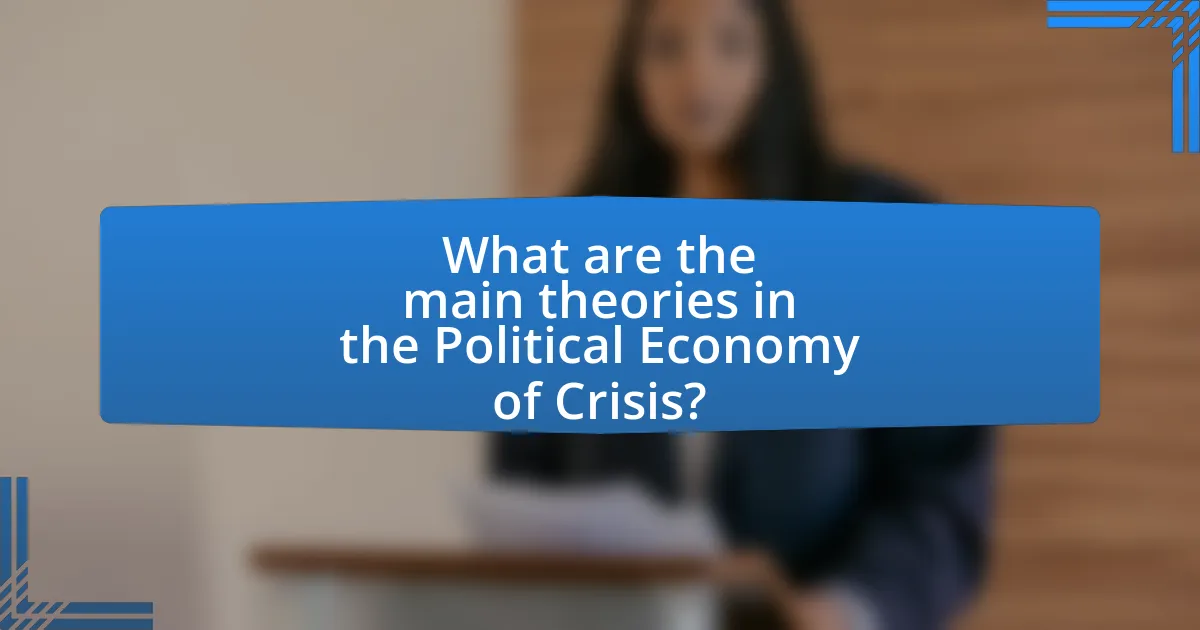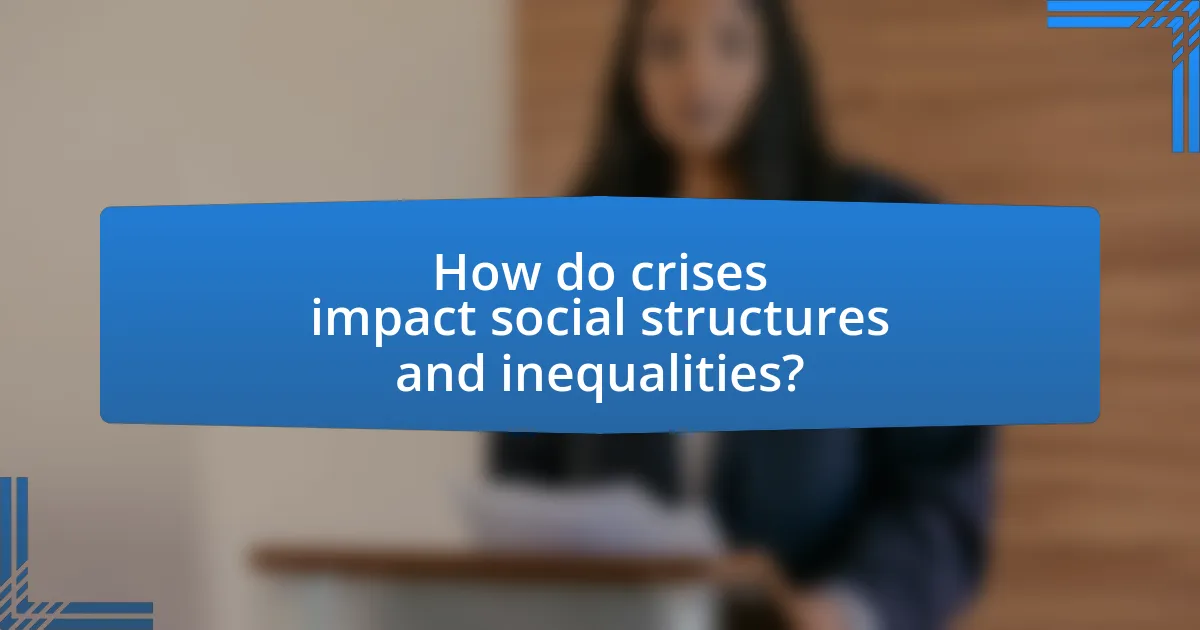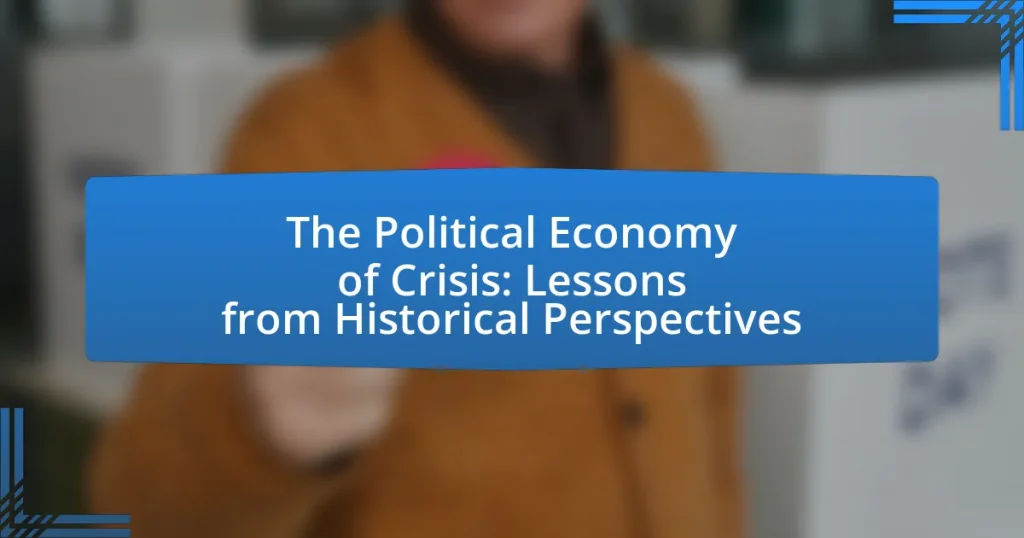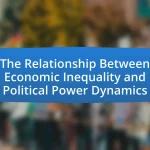The Political Economy of Crisis examines the interplay between economic factors and political structures during crises, highlighting how historical events like the Great Depression and the 2008 financial crisis have shaped political and economic systems. The article explores key historical examples, the responses of different political ideologies to economic downturns, and the implications of various economic theories for policy-making. It emphasizes the importance of understanding past crises to inform contemporary strategies, address social inequalities, and enhance resilience in future economic challenges. Additionally, the role of international organizations in crisis management is discussed, underscoring their significance in coordinating responses and providing support during global emergencies.

What is the Political Economy of Crisis?
The Political Economy of Crisis refers to the study of how economic factors and political structures interact during times of crisis, influencing both the causes and consequences of such events. This field examines how crises, such as financial collapses or social upheavals, are shaped by power dynamics, institutional frameworks, and economic policies. Historical examples, such as the Great Depression of the 1930s, illustrate how government responses, like the New Deal in the United States, were influenced by political ideologies and economic theories, demonstrating the interconnectedness of politics and economics in crisis situations.
How do historical crises shape political and economic systems?
Historical crises significantly shape political and economic systems by prompting structural changes and policy reforms. For instance, the Great Depression of the 1930s led to the establishment of welfare states and regulatory frameworks in many countries, fundamentally altering the relationship between governments and economies. This crisis resulted in the implementation of the New Deal in the United States, which introduced social security, labor rights, and financial regulations, demonstrating how crises can catalyze comprehensive reforms. Similarly, the 2008 financial crisis prompted global shifts in banking regulations, such as the Dodd-Frank Act, which aimed to prevent future economic collapses. These examples illustrate that historical crises often serve as turning points, reshaping governance and economic practices in response to failures and demands for change.
What are the key historical examples of crises influencing political economies?
Key historical examples of crises influencing political economies include the Great Depression of the 1930s, the 1973 oil crisis, and the 2008 financial crisis. The Great Depression led to significant changes in economic policy, including the introduction of the New Deal in the United States, which expanded government intervention in the economy. The 1973 oil crisis caused inflation and economic stagnation, prompting shifts in energy policy and economic strategies globally. The 2008 financial crisis resulted in widespread economic downturns and led to regulatory reforms such as the Dodd-Frank Act in the U.S., aimed at preventing future financial instability. Each of these crises reshaped political economies by altering government roles, economic policies, and regulatory frameworks.
How do different political ideologies respond to economic crises?
Different political ideologies respond to economic crises in distinct ways, reflecting their core principles and values. For instance, capitalism typically emphasizes market solutions, advocating for minimal government intervention, which can lead to austerity measures during crises, as seen in the 2008 financial crisis where many governments prioritized budget cuts over stimulus spending. In contrast, socialism advocates for increased government intervention and public ownership, often implementing expansive fiscal policies to stabilize the economy, as demonstrated by the New Deal in the United States during the Great Depression, which aimed to provide relief and recovery through government programs. Additionally, populism may respond to economic crises by promoting nationalist policies and direct appeals to the public, often prioritizing immediate relief measures over long-term structural reforms, as observed in various Latin American countries during economic downturns. These ideological responses shape the effectiveness and consequences of policies enacted during crises, influencing recovery trajectories and social equity.
Why is understanding the political economy of crisis important?
Understanding the political economy of crisis is important because it reveals the underlying economic and political structures that shape responses to crises. Analyzing historical crises, such as the Great Depression or the 2008 financial crisis, demonstrates how economic policies and political decisions can exacerbate or mitigate the impacts of such events. For instance, during the Great Depression, government intervention through the New Deal significantly influenced recovery trajectories, highlighting the role of state action in economic crises. This understanding allows policymakers to craft informed strategies that address both immediate needs and long-term structural issues, ultimately leading to more resilient economies and societies.
What lessons can be learned from past crises?
Past crises reveal critical lessons about the importance of preparedness, effective communication, and the need for robust institutional frameworks. Historical events, such as the 2008 financial crisis, demonstrate that inadequate regulatory oversight can lead to systemic failures, emphasizing the necessity for proactive measures in financial governance. Additionally, the COVID-19 pandemic highlighted the significance of transparent communication from authorities to maintain public trust and compliance during emergencies. Furthermore, crises often expose social inequalities, underscoring the need for policies that address disparities and promote resilience in vulnerable populations. These lessons underscore the value of learning from history to enhance future crisis management strategies.
How do these lessons apply to contemporary issues?
The lessons from historical perspectives on the political economy of crisis apply to contemporary issues by highlighting the cyclical nature of economic downturns and the importance of government intervention. For instance, the Great Depression of the 1930s demonstrated that unregulated markets can lead to severe economic instability, a lesson echoed in the 2008 financial crisis, where lack of oversight contributed to widespread economic failure. Historical data shows that countries implementing stimulus measures during crises, such as the New Deal in the U.S., experienced quicker recoveries, reinforcing the need for proactive fiscal policies in today’s economic challenges.

What are the main theories in the Political Economy of Crisis?
The main theories in the Political Economy of Crisis include Marxist theory, which emphasizes the role of class struggle and capital accumulation in generating economic crises; Keynesian theory, which focuses on aggregate demand and the necessity of government intervention during downturns; and Schumpeterian theory, which highlights the importance of innovation and creative destruction in economic cycles. These theories provide frameworks for understanding how economic systems can fail and the socio-political implications of such failures. For instance, Marxist theory posits that inherent contradictions within capitalism lead to periodic crises, while Keynesian theory, as articulated by John Maynard Keynes during the Great Depression, argues that insufficient demand can cause prolonged economic downturns, necessitating state intervention to stimulate recovery.
How do various economic theories explain crises?
Various economic theories explain crises through different lenses, highlighting factors such as market failures, systemic risks, and behavioral economics. Classical economics attributes crises to external shocks or misallocations of resources, while Keynesian theory emphasizes insufficient aggregate demand leading to economic downturns. For instance, the Great Depression of the 1930s illustrated Keynesian principles, where decreased consumer spending resulted in widespread unemployment and business failures.
Monetarist theory, on the other hand, points to the role of money supply and inflation, suggesting that inappropriate monetary policy can trigger crises, as seen in the hyperinflation of Weimar Germany in the 1920s. Additionally, Austrian economics focuses on the boom-bust cycle, arguing that artificially low interest rates lead to malinvestment, culminating in economic crises, exemplified by the 2008 financial crisis, which was partly driven by excessive credit expansion.
Behavioral economics introduces psychological factors, asserting that irrational behavior and herd mentality can exacerbate crises, as evidenced by the dot-com bubble in the late 1990s, where speculative investments led to a market crash. Each theory provides a distinct framework for understanding the complexities of economic crises, supported by historical examples that validate their claims.
What role do Keynesian and Neoliberal perspectives play in crisis analysis?
Keynesian and Neoliberal perspectives play crucial roles in crisis analysis by offering distinct frameworks for understanding economic downturns and policy responses. Keynesian economics emphasizes the importance of government intervention during crises, advocating for fiscal stimulus to boost demand and mitigate unemployment, as evidenced by the New Deal policies during the Great Depression. In contrast, Neoliberalism prioritizes market mechanisms and minimal government intervention, arguing that crises are often the result of excessive regulation and that recovery should rely on free-market solutions, as seen in the policies implemented during the 1980s under leaders like Ronald Reagan and Margaret Thatcher. These differing approaches shape the analysis of crises by influencing the strategies policymakers adopt to address economic challenges.
How do Marxist theories interpret economic crises?
Marxist theories interpret economic crises as inherent contradictions within the capitalist system, primarily stemming from the conflict between the forces of production and the relations of production. According to Marx, capitalism is characterized by cycles of overproduction, where goods are produced beyond the capacity of consumers to purchase them, leading to economic downturns. This phenomenon is evidenced by historical events such as the Great Depression of the 1930s, which highlighted the instability of capitalist economies. Additionally, Marxist analysis emphasizes that crises serve as mechanisms for capital accumulation, allowing stronger capitalists to consolidate power and resources at the expense of weaker competitors, thereby perpetuating class struggle and inequality.
What are the implications of these theories for policy-making?
The implications of theories related to the political economy of crisis for policy-making include the necessity for adaptive governance and proactive economic strategies. These theories highlight that crises often reveal structural weaknesses in economies, necessitating policies that address underlying vulnerabilities rather than merely responding to immediate symptoms. For instance, historical analysis shows that during the Great Depression, policies focused on economic stimulus and social safety nets were crucial for recovery, as evidenced by the New Deal programs implemented in the United States. Such insights inform contemporary policy-making by emphasizing the importance of resilience and long-term planning in economic frameworks, ensuring that policies are not only reactive but also preventive in nature.
How can policymakers use historical lessons to mitigate future crises?
Policymakers can use historical lessons to mitigate future crises by analyzing past responses to similar situations and adapting successful strategies. For instance, during the 2008 financial crisis, governments implemented stimulus packages and regulatory reforms that helped stabilize economies, demonstrating the effectiveness of timely intervention. Additionally, studying the Great Depression reveals the importance of coordinated international responses to prevent economic collapse, as seen in the establishment of the Bretton Woods system. By applying these historical insights, policymakers can create more resilient frameworks that anticipate and address potential crises effectively.
What are the potential pitfalls of ignoring historical perspectives?
Ignoring historical perspectives can lead to a lack of understanding of the complexities of current political and economic crises. This oversight may result in repeating past mistakes, as evidenced by the 2008 financial crisis, which mirrored the 1929 Great Depression in its underlying causes, such as excessive risk-taking and inadequate regulatory frameworks. Additionally, neglecting historical context can hinder effective policy-making, as policymakers may fail to recognize patterns and lessons learned from previous crises, ultimately exacerbating the situation. Historical analysis provides critical insights into the socio-economic factors that shape crises, and without this knowledge, responses may be misguided or ineffective.

How do crises impact social structures and inequalities?
Crises significantly disrupt social structures and exacerbate existing inequalities. During economic downturns, for instance, marginalized groups often face higher unemployment rates and reduced access to essential services, leading to a widening wealth gap. Historical evidence from the 2008 financial crisis shows that low-income households experienced a disproportionate loss of wealth, with studies indicating that the bottom 20% of earners lost 40% of their net worth, while the top 20% saw minimal impact. Additionally, crises can lead to shifts in power dynamics, as those in privileged positions may consolidate their advantages, further entrenching social hierarchies. The COVID-19 pandemic illustrated this, where data revealed that Black and Hispanic communities faced higher infection and mortality rates, highlighting systemic inequalities in healthcare access. Thus, crises not only challenge existing social frameworks but also intensify disparities among different societal groups.
What are the social consequences of economic crises?
Economic crises lead to significant social consequences, including increased unemployment, heightened poverty levels, and social unrest. For instance, during the 2008 financial crisis, the unemployment rate in the United States peaked at 10%, resulting in millions losing their jobs and homes, which exacerbated poverty and inequality. Additionally, economic downturns often lead to a decline in mental health, as individuals face financial stress and uncertainty, with studies indicating a rise in depression and anxiety during such periods. Furthermore, social cohesion can deteriorate, as communities experience increased tensions and conflicts over scarce resources, evidenced by protests and riots that frequently accompany economic hardship.
How do crises exacerbate existing inequalities?
Crises exacerbate existing inequalities by disproportionately impacting marginalized groups, leading to greater economic and social disparities. For instance, during the COVID-19 pandemic, low-income workers faced higher job losses and health risks compared to higher-income individuals, as evidenced by a report from the Economic Policy Institute which found that 40% of low-wage workers lost their jobs during the initial lockdowns, while only 13% of high-wage workers experienced similar losses. Additionally, access to healthcare and social services became more limited for disadvantaged populations during crises, further entrenching inequality. Historical data shows that economic downturns, such as the Great Depression, similarly widened the wealth gap, as wealthier individuals were better positioned to weather financial shocks.
What demographic groups are most affected during crises?
Vulnerable demographic groups most affected during crises include low-income individuals, racial and ethnic minorities, women, children, and the elderly. These groups often experience heightened risks due to pre-existing social inequalities, limited access to resources, and inadequate support systems. For instance, during the COVID-19 pandemic, studies indicated that low-income communities faced higher infection rates and economic hardships, while racial and ethnic minorities experienced disproportionate health impacts, as reported by the Centers for Disease Control and Prevention. Additionally, women and children are often more susceptible to domestic violence and economic instability during crises, as highlighted by the United Nations.
How can historical perspectives inform social policy during crises?
Historical perspectives can inform social policy during crises by providing insights into past responses and outcomes, which can guide current decision-making. For example, the Great Depression of the 1930s led to the establishment of social safety nets like Social Security in the United States, demonstrating the effectiveness of government intervention in stabilizing the economy and supporting vulnerable populations. Analyzing these historical events allows policymakers to understand the consequences of various approaches, such as austerity versus stimulus, and to adopt strategies that have proven successful in mitigating the impacts of crises.
What strategies have been effective in addressing social inequalities during past crises?
Effective strategies for addressing social inequalities during past crises include targeted government interventions, social safety nets, and community engagement initiatives. For instance, during the Great Depression, the New Deal programs in the United States provided jobs, financial assistance, and infrastructure development, significantly reducing poverty levels and inequality. Similarly, during the COVID-19 pandemic, countries that implemented direct cash transfers and expanded unemployment benefits, such as Canada and Germany, saw a decrease in economic disparities. These historical examples demonstrate that proactive government policies and community support systems can mitigate the impacts of crises on vulnerable populations.
How can lessons from history guide current social interventions?
Lessons from history can guide current social interventions by providing evidence-based insights into the effectiveness of various strategies. Historical examples, such as the New Deal during the Great Depression, illustrate how government intervention can stabilize economies and reduce unemployment. Research shows that targeted social programs, like those implemented in post-war Europe, led to significant improvements in social welfare and economic recovery. By analyzing past successes and failures, policymakers can design interventions that are more likely to achieve desired outcomes, thereby enhancing the efficacy of current social initiatives.
What practical strategies can be derived from historical lessons in the Political Economy of Crisis?
Practical strategies derived from historical lessons in the Political Economy of Crisis include implementing robust regulatory frameworks, enhancing social safety nets, and fostering international cooperation. Historical events, such as the Great Depression, demonstrate that strong regulatory measures can prevent financial excesses and stabilize economies. For instance, the establishment of the Securities and Exchange Commission in 1934 aimed to restore investor confidence and regulate the stock market. Additionally, the 2008 financial crisis highlighted the importance of social safety nets, as countries with stronger welfare systems were better equipped to mitigate the impacts on vulnerable populations. Lastly, international cooperation, as seen in the response to the 2008 crisis through coordinated monetary policies among central banks, proved essential in addressing global economic challenges effectively.
How can governments prepare for future economic crises based on historical insights?
Governments can prepare for future economic crises by implementing proactive fiscal policies, enhancing regulatory frameworks, and establishing robust safety nets, as evidenced by historical responses to past crises. For instance, during the Great Depression, the U.S. government introduced the New Deal, which focused on job creation and infrastructure investment, demonstrating the effectiveness of government intervention in stabilizing the economy. Additionally, the 2008 financial crisis highlighted the importance of regulatory oversight, leading to reforms such as the Dodd-Frank Act, which aimed to prevent systemic risks in the financial sector. Historical insights indicate that timely and decisive actions, such as increasing public spending during downturns and ensuring financial institutions are adequately regulated, can mitigate the impacts of economic crises.
What role do international organizations play in crisis management?
International organizations play a crucial role in crisis management by providing coordination, resources, and expertise to address global challenges. They facilitate collaboration among member states, enabling a unified response to crises such as natural disasters, humanitarian emergencies, and economic downturns. For instance, the United Nations coordinates international humanitarian efforts during crises, mobilizing funding and resources to support affected populations. Additionally, organizations like the World Health Organization offer technical guidance and support during health emergencies, as seen during the COVID-19 pandemic, where they provided critical information and coordinated global responses. These actions demonstrate the effectiveness of international organizations in enhancing resilience and facilitating recovery in times of crisis.


